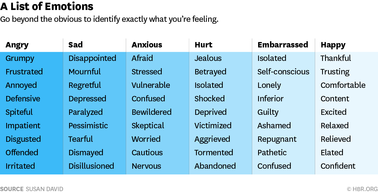 There are some great lessons that children can teach us, and even at 4 months of age my son is teaching me one: the power of emotional agility. On a daily basis infants experience several emotions – happiness, surprise, fear, interest, frustration, pain – often in the space of a few hours and sometimes minutes! What I notice, however, is that their emotions are not held onto - they are fluid. I mean, have you ever seen an infant hold a grudge or stay upset after its needs have been met? I on the other hand am not always so fluid with my emotions….and I know I am not alone.  How often do we disagree with a friend, family member or spouse and hold onto that emotion of frustration or disappointment or hurt for hours, sometimes days? How common is it for us to dwell and ruminate about how someone reacted to us at work, how we behaved in a certain situation, about something we said or wish we had said and so on? In the river of life there is a continuous stream of emotions, but we don’t always let them flow (especially the negative ones). The flow of our emotions can often be obstructed and slowed to a trickle; sometimes the flood gates are opened and a torrent rushes through us. Emotional agility is the ability to fully feel and accept our emotions, while remaining flexible and able to move away from beliefs and feelings that keep us stuck in the past. So how can we increase our emotional agility? To become emotionally agile, we first need to give ourselves permission to experience and feel what we are feeling. Research shows us that avoiding our feelings can impact our health – diminishing our wellbeing and creating symptoms of stress like headaches. One study conducted by psychologists from Harvard found that suppressing emotions may even increase the risk of dying from heart disease and certain forms of cancer. So whatever emotions are welling up within us - positive or negative - let us feel them! Our emotional agility depends on us feeling these sometimes difficult emotions, but also involves us letting them go since studies have demonstrated a link between unhappiness and dwelling on negative emotions and events. Another way we can let our emotions flow is to define them. It sounds odd, but research shows that when we can differentiate our emotions using an expanded emotional vocabulary we are less overwhelmed by stress and are less susceptible to unhealthy emotion-regulation strategies such as binge drinking and eating or aggression. This same research reveals that when children are taught this broad knowledge of emotion words their social behavior and academic performance in school improve. Write it out I’ve previously written about the health benefits of journaling. With regard to emotional agility, research shows that people who write about emotionally charged episodes are healthier both physically and mentally. Writing allows us to gain new perspectives on what our feelings mean (or don’t mean!) and can remind us that emotions are temporary and fleeting and not essential part of our being. Using phrases such as “I have learned,” “It struck me that,” “the reason that,” “I now realize,” and “I understand” can help detach yourself from your feelings, which can free you from rumination and lets you move forward. Practice Mindfulness A mindfulness practice often includes the practice of equanimity, or non-judgmental awareness and acceptance, which can also enhance our emotional agility. Maintaining an intentional, non-judgmental awareness toward our thoughts and emotions remind us that it’s okay to have negative feelings and thoughts, that we don’t have to fight them or judge them and that we can let them go. In a mindfulness practice the breath is an essential tool, which can help us manage difficult emotions. Taking a breath triggers our parasympathetic nervous system to kick in, reducing our blood pressure, muscle tension and getting us out of the fight-or-flight state that emotions can often provoke. Forgive deeply Whether it’s a small disagreement with your spouse or a yearlong grudge toward a family member or friend, unresolved conflict negatively impacts our physical health. The good news: studies have found that the act of forgiveness can lower the risk of heart attack, improve cholesterol levels and sleep, and reduce blood pressure, and levels of anxiety, depression and stress. Start today and offer compassion and empathy to those who have wronged you and to yourself. Take in the good A final way to enhance our emotional agility is to take in the good. I wrote about this last month and in prior posts and it remains a savvy brain-science way to actively improve how we feel, helping us become more resilient, confident and happy. Sure my 4 month old may not hold onto negative emotions because he is still forming his long term memory, but he is still a role model for us all. Ruminating on the negative usually just causes unnecessary suffering. May we all get to the root of what we’re feeling and express it to ourselves via writing and to others. May we take deep breaths when our emotions overwhelm us, forgive one another and intentionally savor the good in life - even the simple things like someone holding the door open for us. Or as my husband’s Grandpa used to say - success was going to the toilet, every morning. *The term emotional agility was inspired by Susan David, PhD.'s book. If you'd like to take a quiz that measures your emotional agility check out her website!
4 Comments
7/23/2018 06:56:12 am
You know what, this is a great realization. Funny how I never realized such thing even though I had the chance to take care of an infant as well before.. He's actually my nephew. Anyway, this really hit me because I definitely have these situations before and even up to now. But since you have given us some background regarding this, rest assured I will make some major changes with my life and how I deal with emotional matters. I will definitely take down some notes about this so that I won't forget about it. Thanks for this helpful insights.
Reply
Anger is an indicator that something doesn't feel right. It isn't fun to feel angry, but sometimes it's easier to feel anger than to acknowledge (and actually feel) all of the vulnerable feelings that sit underneath the anger. Vulnerable feelings like grief, shame, and disappointment can feel uncomfortable and painful. We can sometimes use anger to protect ourselves from feeling this vulnerability and pain.
Reply
Anger is an indicator that something doesn't feel right. It isn't fun to feel angry, but sometimes it's easier to feel anger than to acknowledge (and actually feel) all of the vulnerable feelings that sit underneath the anger. Vulnerable feelings like grief, shame, and disappointment can feel uncomfortable and painful. We can sometimes use anger to protect ourselves from feeling this vulnerability and pain.
Reply
Leave a Reply. |
AuthorHello and welcome! My name is Andrea Notch Mayzeles. I am a Certified Health Education Specialist, Mom, and Master of Public Health dedicated to the path of well-being. As a wellness professional I am committed to continued learning and am here to share research, recipes and musings on health, psychology, personal development, and parenting. I hope you enjoy! Categories
All
|

 RSS Feed
RSS Feed